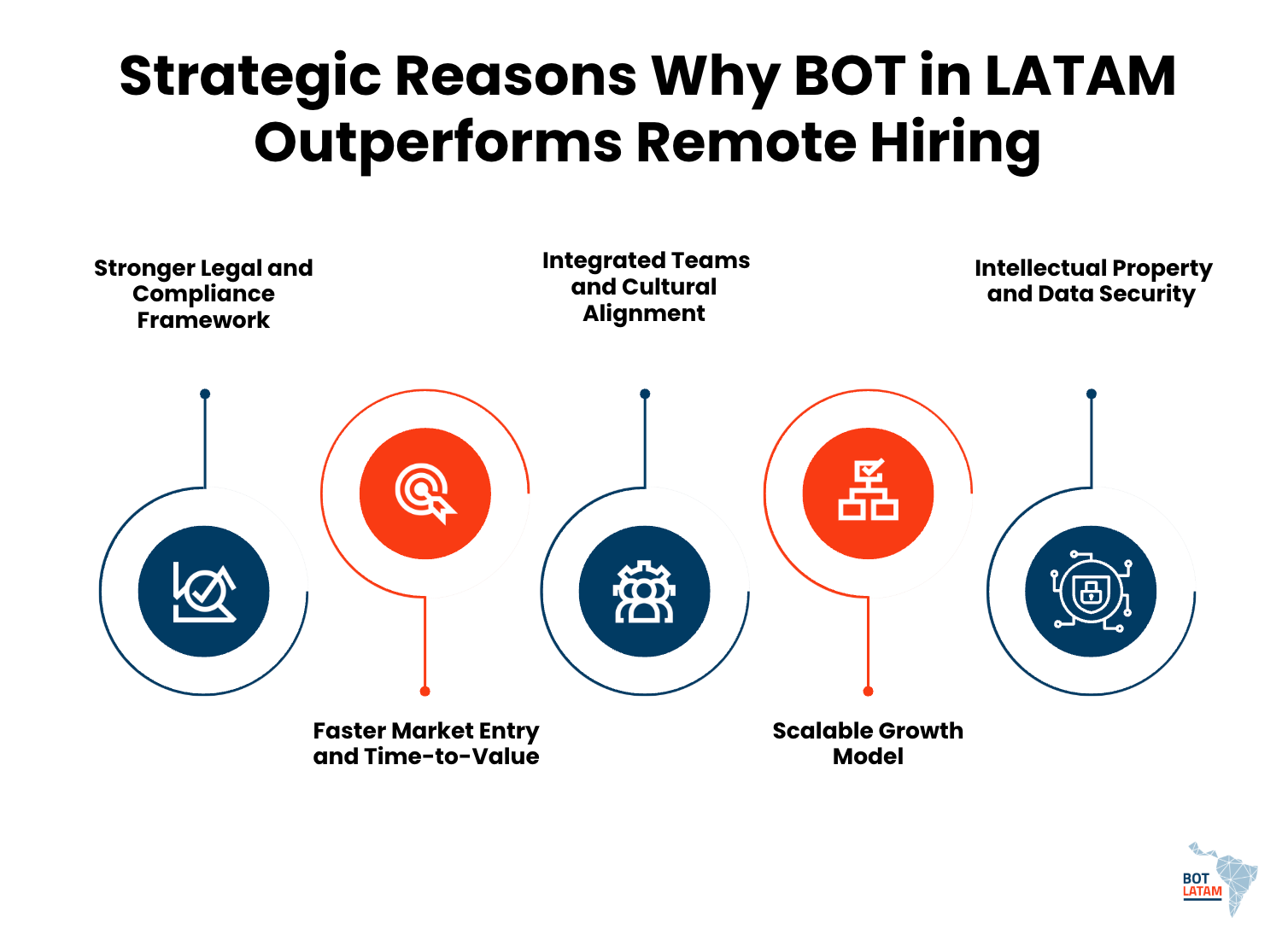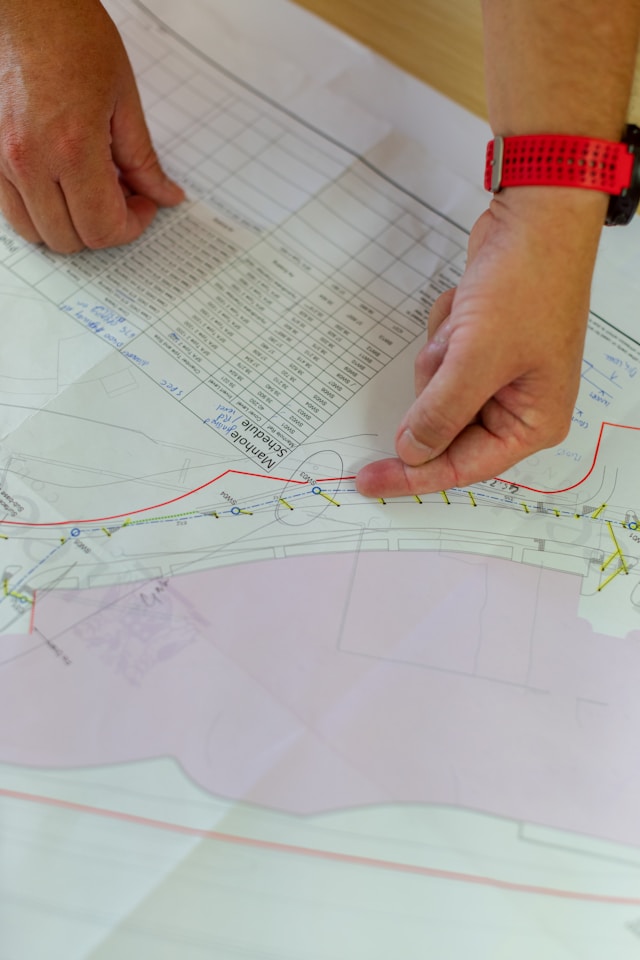When companies expand globally, hiring remotely isn’t always enough. Many are realizing that the Build-Operate-Transfer (BOT) model, especially in Latin America’s nearshore markets, offers a smarter, more scalable way to grow teams with lasting control and ROI.
According to Deloitte, 65% of organizations plan to increase nearshore investments to strengthen operational agility and reduce risk. That shift reflects a growing awareness that remote hiring alone can’t deliver the same level of ownership, compliance, and integration that BOT structures provide.
In this article, you’ll explore why BOT in Latin America consistently outperforms remote hiring, what makes it ideal for building scalable teams, and how it leverages regional advantages like proximity, talent depth, and cultural alignment. You’ll also learn how to transition from remote models to BOT, and what to look for in a trusted nearshore partner.
Let’s break down why more global companies are choosing to build, operate, and transfer their teams in Latin America.
Why Latin America Has Become a Top Region for BOT Operations
Latin America has quietly become one of the strongest regions for Build-Operate-Transfer (BOT) operations, attracting companies that want more control over nearshore expansion. What makes it stand out isn’t just lower costs, it’s a mix of talent maturity, infrastructure readiness, and strategic proximity that few other regions can match.
Skilled and Scalable Talent Pool.
Latin America offers one of the fastest-growing tech workforces in the world. According to the World Bank, over 1.2 million STEM graduates enter the labor market annually across the region, creating a sustainable pipeline for companies building long-term operations. Countries like Colombia, and Brazil lead with strong engineering and software development ecosystems, while smaller markets such as Uruguay and Costa Rica have become innovation hubs for fintech, AI, and SaaS companies.
This talent depth gives BOT investors a critical advantage: you can start with small specialized teams and scale quickly without sacrificing skill quality or productivity.
Strategic Nearshore Location.
Proximity matters. Latin America’s shared time zones with North America make real-time collaboration seamless, a major advantage compared to offshore destinations in Asia or Eastern Europe. For example, Mexico City, Bogotá, and Buenos Aires align within one to three hours of U.S. business hours, enabling continuous communication and faster decision-making.
This geographic closeness also reduces travel costs and boosts relationship-building through regular onsite visits. For organizations adopting the BOT model, those face-to-face connections strengthen team cohesion and operational oversight during the “operate” phase.
Business-Friendly Ecosystem.
Governments across LATAM have invested heavily in foreign investment incentives and tech infrastructure to attract nearshore partnerships. Chile, Mexico, and Colombia, for instance, offer tax benefits and streamlined regulatory frameworks for foreign investors setting up BOT operations. According to IDB Invest, these initiatives have driven a 40% increase in nearshore service exports over the past five years.
Many countries also maintain strong intellectual property protections and trade agreements with the U.S. and Europe, reducing compliance risks when transferring operational ownership under a BOT model.
Competitive Cost Efficiency.
While BOT is not just about cost, Latin America remains highly competitive on that front. Average software engineering salaries are 40–60% lower than in the U.S. According to NASSCOM and Glassdoor data analysis, but without the hidden costs often seen in remote hiring models, like high turnover or poor local compliance management.
This cost-effectiveness extends beyond labor. Local operational support, infrastructure, and administrative services are significantly more affordable than in other nearshore or offshore regions, improving your long-term ROI once the transfer phase is complete.
BOT vs Remote Hiring: What’s the Real Difference?
The Build-Operate-Transfer (BOT) model and remote hiring both help companies expand globally, but they serve very different purposes. The main distinction comes down to ownership, control, and scalability. While remote hiring offers short-term flexibility, BOT provides a structured path toward building a fully owned operation in a foreign market.
1. Ownership and Long-Term Control:
In a remote hiring setup, the talent usually works under third-party contracts or as freelancers. You manage output but don’t own the infrastructure, tools, or local entity. In contrast, BOT allows your company to own the team, assets, and operations once the transfer phase is complete.
That difference in ownership is strategic. Under a BOT model, every process, from hiring to compliance, is set up according to your standards. By the end of the “operate” phase, you gain a fully functional branch of your company rather than a loosely connected remote workforce. This structure supports sustainable growth instead of temporary staffing fixes.
2. Operational Control and Risk Management:
BOT models give you greater control over daily operations, HR policies, and quality standards. The local BOT partner helps set up and run the operation initially, but you maintain visibility across all key decisions. Once the transfer occurs, the entire operation becomes yours.
Remote hiring, however, limits visibility and exposes you to compliance risks. A 2023 Globalization Partners report found that over 42% of companies faced unexpected legal or tax complications when managing remote workers across borders. BOT mitigates that by ensuring local labor, tax, and regulatory requirements are handled before the transfer, protecting your brand and minimizing liability.
3. Integration and Collaboration:
Cultural alignment and collaboration also differ between the two models. In remote hiring, teams often operate in isolation, which can slow down onboarding and reduce engagement. BOT setups, on the other hand, emphasize integration from day one. Teams are built to reflect your culture and workflows, supported by local HR and management structures that mirror your internal organization.
This alignment boosts retention and performance. According to Harvard Business Review, companies that invest in structured integration processes see 30% higher employee engagement and 25% faster productivity ramp-up compared to unstructured remote setups.
4. Scalability and Strategic Flexibility:
Remote hiring can work for quick staffing needs, but scaling across multiple roles or departments often becomes inefficient. Each new hire adds more administrative and compliance complexity. BOT, by design, scales systematically, allowing you to grow from a small pilot team to a full regional hub without rebuilding infrastructure each time.
This scalability is one of BOT’s strongest advantages. A Deloitte survey on global sourcing found that 68% of organizations using BOT structures reported smoother scaling and lower per-employee setup costs than companies relying solely on remote hiring.
5. Financial Transparency and ROI:
When hiring remotely, hidden costs, like turnover, third-party fees, and local compliance gaps, can erode savings over time. BOT models, in contrast, have defined cost structures and transparent budgeting across each phase. You know exactly what you’re investing in, and you eventually own the operation, turning what was once an expense into a long-term asset.
This clarity makes BOT ideal for companies seeking financial predictability and strategic presence in Latin America’s fast-growing markets.
Strategic Reasons Why BOT in LATAM Outperforms Remote Hiring

The Build-Operate-Transfer (BOT) model in Latin America has evolved into a proven framework for companies seeking sustainable global growth. Unlike remote hiring, which focuses on individual talent, BOT focuses on building long-term operational capacity that aligns with your business strategy. Here’s why it consistently delivers stronger results.
1. Stronger Legal and Compliance Framework.
Compliance is a major differentiator. Each LATAM country has unique labor, tax, and data protection laws. Under BOT, your local partner establishes the operation in full compliance from day one, ensuring a seamless, risk-free transfer.
According to EY’s Global Risk Survey, legal noncompliance in cross-border hiring can cost companies up to $4 million annually in fines and remediation. The BOT approach minimizes those risks because compliance frameworks are integrated directly into your operation, not outsourced or loosely managed through remote contracts.
2. Faster Market Entry and Time-to-Value.
Speed matters when entering a new region. Remote hiring can take months to coordinate due to individual onboarding, legal paperwork, and infrastructure gaps. BOT accelerates the process by leveraging local expertise and ready-made networks, allowing you to set up an operational base in weeks, not quarters.
The Inter-American Development Bank reported that companies expanding through nearshore operational models in LATAM achieved market entry 40% faster than those using traditional remote or offshore setups. That time advantage translates directly into earlier revenue capture and competitive positioning.
3. Integrated Teams and Cultural Alignment.
Cultural alignment is often underestimated in distributed hiring. With BOT, teams are built and managed locally but designed to mirror your company’s structure and values. This ensures smoother integration once the transfer phase occurs.
LATAM’s professional culture, collaborative, entrepreneurial, and relationship-driven, fits naturally with North American and European business environments. EF English Proficiency Index ranks multiple Latin American countries in the top third globally for English fluency, easing communication and reducing friction.
4. Scalable Growth Model.
BOT allows you to scale without the typical growing pains of remote hiring. As your needs evolve, the local operation can expand from small agile teams to full departments under a unified management system.
A Deloitte Global Outsourcing Survey found that 72% of organizations using BOT models reported smoother scaling and better talent retention than those relying solely on remote workers. This structure gives you predictable growth capacity, vital for companies entering fast-moving markets like Mexico, Colombia, and Chile.
5. Intellectual Property and Data Security.
Remote hiring often raises data protection issues when contractors use personal devices or unregulated systems. BOT operations follow local and international data security standards, giving you confidence that intellectual property and client data remain protected under your company’s direct control.
Latin America has strengthened its data laws to align with GDPR and U.S. privacy standards, making it one of the safest emerging regions for knowledge-intensive operations. For companies handling sensitive data, like fintech, SaaS, or healthcare, this adds an extra layer of strategic assurance.
Ready to Start Hiring Remote Talent Through BOT LATAM?
The Build-Operate-Transfer (BOT) model is redefining how global companies scale in Latin America. As talent markets mature and infrastructure strengthens, more organizations are moving beyond remote hiring to establish owned, compliant, and high-performance operations that deliver measurable long-term value.
At BOT LATAM, we help companies build and transfer fully operational teams across Latin America, combining regional expertise, legal compliance, and scalable infrastructure. Our approach ensures every stage, from setup to transfer, is aligned with your strategic goals and governance standards. With deep experience in nearshore team development and operational management, we partner with organizations ready to expand intelligently, reduce risk, and secure lasting control of their global talent base. Are you ready to get started? Contact us to schedule a consultation!

Revolutionize Your Workflow with Our Innovative BOT Strategy!
Enhance your operations seamlessly and adapt to market demands
Contact Us



